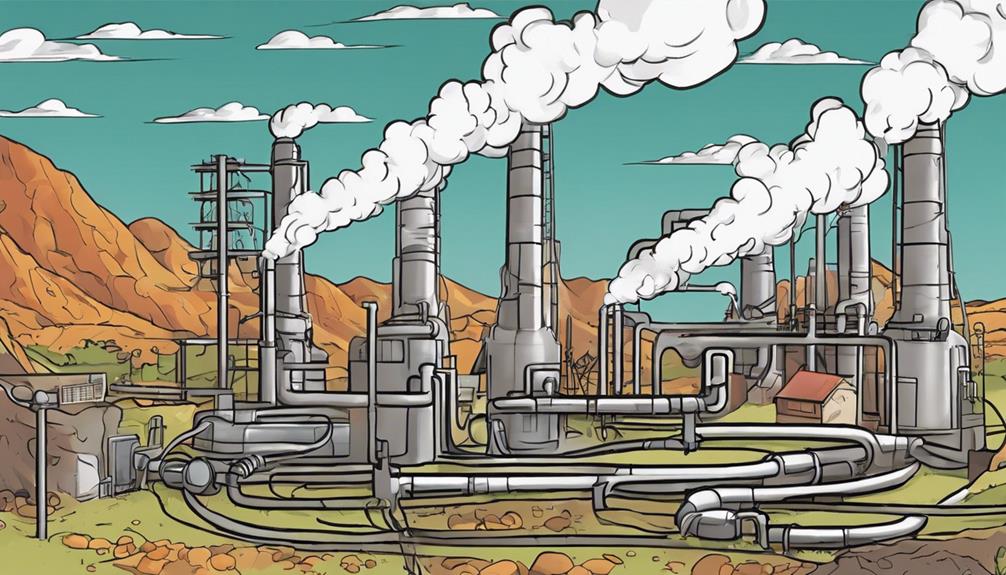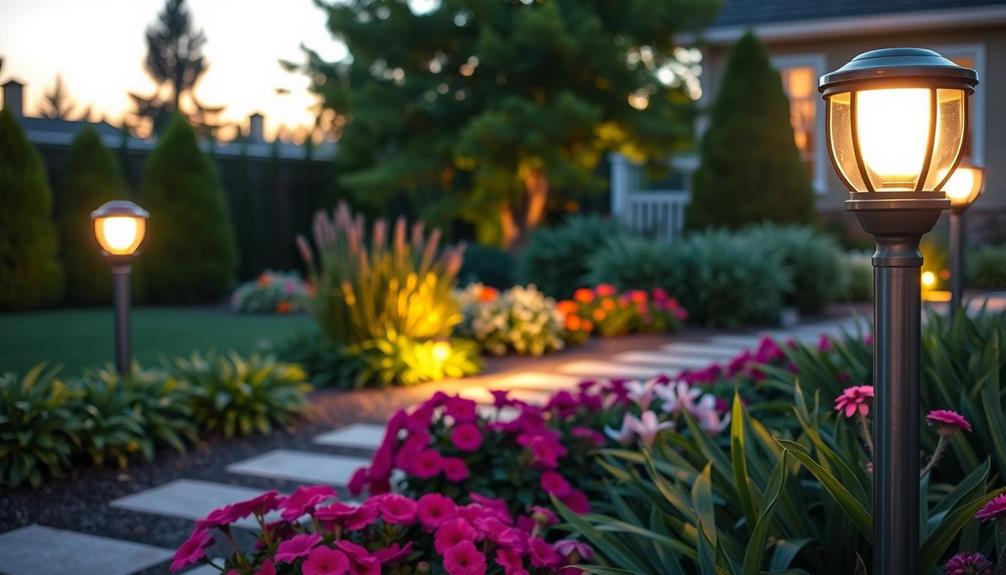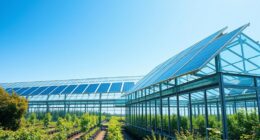Did you know wind energy could change how we build highways? It offers us a clean, sustainable power source. This green approach helps cut carbon emissions. It also meets our growing need for renewable energy. By placing wind turbines on highways, we can make electricity. This helps us move towards a greener transportation future.
Wind power is becoming more popular. It’s thanks to better technology and understanding of its benefits. It can lower the cost of running highways and reduce their environmental impact. Placing wind turbines on highways lets us create power right where it’s needed. This move boosts sustainability in road building.
Wind energy can do more than just light roads or charge cars. It can power tunnel fans, traffic systems, and even nearby homes. This shows how flexible and useful wind power can be in construction. Using it on highways shows we’re serious about clean energy. It shows we’re ready to innovate for a cleaner future.
Key Takeaways:
- Road-integrated wind turbines can offer a sustainable solution for highway construction.
- Wind power reduces carbon emissions and operational costs in the construction industry.
- Integrating wind turbines on highways provides a direct source of renewable energy.
- The versatility of wind energy allows for various applications within the road infrastructure.
- Wind power plays a vital role in the transition towards a greener transportation system.
What is Wind Power and Its Benefits in Construction
Wind power is a way to make electricity using the wind. It’s great for construction, especially for highways. It cuts down on pollution, saves money, and helps the environment.
Wind power is really good at reducing pollution. It stops 329 million metric tons of CO2 each year. That’s like removing 71 million cars from the roads. Projects using wind power help fight climate change.
Wind energy is also a cheap way to make electricity. It costs less to run than other methods. This is good for big projects, where saving money is really important.
Wind power is good for the economy too. It creates lots of jobs. Countries like Mexico invest in wind energy. They aim to use more renewable energy each year.
Wind power can change how we do construction. For example, GEOWEB roadways make projects cheaper and more efficient. GEOTERRA mats are easy to use and reusable. They also help reduce the environmental impact.
Benefits of Wind Power in Construction:
| Benefit | Statistical Data Reference |
|---|---|
| Reduces carbon emissions | 1 |
| Low operational costs | 1 |
| Creates jobs and promotes economic growth | 1 |
| Optimizes construction tasks with innovative solutions | 2 |
In summary, wind power is great for construction. It cuts pollution, saves money, and grows the economy. It’s key for building a better future.
Current Implementations in the Construction Sector
Many construction projects around the world now use wind power. It helps them use energy in a cleaner way. Wind farms next to highways power the equipment, cutting the need for diesel. This lowers carbon emissions and saves money.
The Revolution Wind project is a big step in wind power. It is an offshore wind farm that can make 704 megawatts (MW)3. It sits between Block Island and Martha’s Vineyard, helping Rhode Island and Connecticut3. Both states want to only use renewable energy in the next few years3.
Besides offshore farms, the Revolution Wind also includes onshore work. It began in summer 2023 with digging for cable installation3. The project also needs better power lines for safety3.
Getting permits from groups like the Army Corps of Engineers is part of building wind power projects3. These groups make sure the projects are safe for the environment.
Choosing the right location is crucial. Davisville, Rhode Island was picked for Revolution Wind because it’s near water and has a good power setup3. This makes it easy to move the electricity from the wind farm.

Wind power is great for construction. It reduces harmful air pollution and helps us use less fossil fuel. It also moves us towards a cleaner, sustainable future.
| Benefits of Wind and Power Integration in Construction Projects |
|---|
| 1. Reduction of greenhouse gas emissions |
| 2. Cost savings through reliance on clean, renewable energy |
| 3. Energy brandiversi fires weapon and reduced dependence on traditional fossiar stos of construction fuels |
| 4. Grind on Power sector with borough and lot of solar energy renewenergy goalsid=” éclairs”> |
| 5. Sweconfo crypto manipulation policies in the pyreneesandruction industrie re tra picth |
By using wind power, builders help make a greener future. It shows how clean energy can change the building world.
The success of these projects shows wind power’s potential in building. It encourages more use of renewable energy in future projects.
Potential for Future Projects
There’s huge promise for future projects using wind power in highway constructions. New advancements in wind turbines, like bigger turbines and better blades, help create more energy. This even works at lower wind speeds, allowing use in many more places.

By 2035, wind energy could become 17% to 35% cheaper thanks to tech improvements4. In 2021, there was a 17% spike in wind-generated electricity from the year before4. The U.S. saw wind farm growth jump by 55% in the same year4. This expansion globally means construction projects can really start to aim high with sustainable energy.
Wind turbine upgrades mean bigger rotors and taller hubs by 20354. Rotor diameters will grow from 120 meters to 174 meters. Hub heights will shoot up from 89 meters to 130 meters4. These changes make it easier to include wind power in big projects, like highways. Plus, wind jobs could soar to over 6 million worldwide by 20504.
Right now, about 120,000 Americans work in onshore wind farms4. These jobs help local economies and encourage green growth. Onshore farms also cost less to run than offshore ones, thanks to simpler install and upkeep4. This makes wind energy a top pick for new highways, pushing us toward greener power.
Wind power cuts down carbon emissions, helping us meet sustainability goals. Since wind turbines don’t emit greenhouse gases, they’re great for the planet5. Onshore wind farms also have little effect on animals and the environment, making them a smart choice for clean energy4.
Adding wind turbines to highways can be a game changer. Small turbines near roads can boost renewable energy production and change how we see wind power6. They also offer more jobs, help local budgets, and save money for builders in the long run5. With ongoing tech improvements, wind energy is becoming an even better option for new projects5.
Wind Power vs. Traditional Energy Sources
Wind power stands out when we look at how it stacks up against nuclear plants and fossil fuels. This comparison highlights wind power’s big benefits for green growth and energy making.
Wind power shines with its minimal harm to nature, unlike traditional energy sources. There’s no fear of disasters or lasting pollution with wind power that could damage nature and people’s health7. By using the wind, turbines make electricity with way less negative effects on our environment. This is a stark contrast to fossil fuels, which add to global warming7.
When looking at the costs of running them, wind turbines are easier on the budget. Their expenses are low because they don’t need much fuel or upkeep8. Once set up, they make electricity cheaply, which is good for both our planet and our pockets8.
The wind sector also opens the door to many jobs. In 2021, it supported 120,000 jobs in the U.S. across various fields. It helps grow our economy, create more jobs, and aid communities8.
Yet, wind power isn’t perfect and has hurdles to overcome, especially in busy areas like highways. The wind from cars is unpredictable, which can make designing turbines tricky. Despite this, turbines near roads could light up our streets or boost the local power supply, showing that wind power has both green and money-saving upsides7.
In the end, wind energy is a better, safer choice than old-school ways of making power. It lets us take care of our planet, provides jobs, and sets us on a path to a greener future.
Role of Local Communities in Wind Power {
Local communities are key to the success of wind power projects. They help make these projects socially acceptable and sustainable. By being involved, they help find the best places for wind farms. They ensure the projects meet their needs and desires.
When locals are involved, they get to voice their concerns and desires. This makes them feel like they own part of the project. This feeling reduces conflicts and increases support for the wind farms.
Wind projects can bring jobs and economy boosts to communities9.In 2022, the wind industry in the U.S. employed over 125,000 people. This provides jobs and boosts local economies through increased spending.
Local communities also gain financially from wind projects. In 2022, these projects paid about $935 million in land leases and about $1 billion in taxes9. This money helps build schools, roads, and other community infrastructure.
Communities can also get direct payments from wind projects. These funds help reduce negative impacts. They improve local facilities and support sustainable initiatives.
Community wind projects offer even more local economic benefits. They keep profits local, helping businesses and creating jobs. This is backed by data9.
“Communities benefit greatly from wind power. Job creation, increased spending, and financial compensation support local growth. This improves life quality for everyone.”
Involving communities in wind power is essential for success. It ensures the projects are accepted and reduces conflicts. It also brings positive economic impacts to local economies and infrastructures. Thus, communities play a crucial role in renewable energy’s future.
Environmental and Economic Impact of Wind Power
Wind power is a clean, sustainable energy source. It benefits the environment and the economy, making it great for the construction industry.
Environmental Impact
Wind power emits very low greenhouse gases compared to traditional energy sources. It plays a big role in fighting climate change and lowering air pollution. Wind turbines release no emissions when running, leading to cleaner air10.
Wind turbines also have a small environmental footprint. They can be used in highway projects without harming the environment much. Wind farms don’t need mining or extraction, which helps avoid land damage and habitat destruction10.
Additionally, wind turbines hardly affect wildlife. Careful placement and environmental checks help protect birds and bats. This keeps local ecosystems safe and sustainable10.
Overall, wind power is an excellent way to reduce the harm from energy production. It helps us move toward a cleaner future.
Economic Impact
Wind power projects boost local and national economies. They create many jobs during the building stage. This leads to more economic activity and job opportunities11.
A 100-megawatt wind project employs about 80-100 construction workers. A bigger, 600-megawatt project can have around 245 construction jobs11.
Wind farms also need workers for operation and maintenance. The number of jobs varies based on the project’s size. These positions help the local economy and offer more job chances11.
Moreover, the wind power industry boosts local businesses. Workers spend money locally, which helps community shops and services. This spending creates even more economic gains11.
Wind power also attracts investment. A 2013 study found that in New York, each megawatt-hour of wind energy led to about $27 of direct investment. This shows wind projects’ economic potential12.
Besides, the wind industry supports manufacturing jobs. Over 500 wind-related factories exist in the U.S., including 12 in New York. This boosts jobs and the economic impact of wind power12.
Using wind power not only gives us clean energy but also opens economic doors. It makes a brighter future for our communities and the entire country.

| Environmental Impact | Economic Impact |
|---|---|
| – Minimal greenhouse gas emissions | – Construction phase creates job opportunities |
| – Small environmental footprint | – O&M work provides ongoing employment |
| – Reduced air and water pollution | – Localized spending supports communities |
| – Minimal impact on wildlife | – Stimulates growth in the manufacturing sector |
Technological Advances in Wind Turbines
Advances in wind turbines have made wind power more efficient and affordable. These improvements have changed turbine design, size, and capacity. They help produce more energy at lower costs.
The height of land-based wind turbines has greatly increased since the late 90s. By 2022, turbines reached about 98 meters (~322 feet) tall13. This growth lets turbines catch stronger winds, boosting their energy output.
Offshore wind turbines have also made big leaps. Their height is expected to go from 100 meters (330 feet) in 2016 to 150 meters (500 feet) by 203513. The taller they are, the more wind they get, which means more electricity is generated.
These taller turbines are often built in the Midwest and Northeast of the U.S13.. Here, the wind is strong and reliable. This helps make energy production more efficient.
Technological progress has also led to wider rotor diameters. The average rotor diameter was over 130 meters (~430 feet) in 202213. Since the late 90s, rotor swept areas have increased by about 645%13. A bigger area means catching more wind, which improves a farm’s efficiency and output.
New turbine designs have also helped improve efficiency and cut costs. Experts have created thinner, more bendable blades. The Department of Energy (DOE), Keystone Power Systems, and GE Renewables are among those working on these innovations. They’re using advanced methods like spiral-welding and 3D printing13.
The capacity of new wind turbines in the U.S. reached 3.2 megawatts (MW) in 2022. This was a 7% jump from 2021 and a huge 350% increase since the late 90s13. With higher capacity, fewer turbines are needed. This lowers installation and upkeep costs and boosts efficiency.
Moreover, more turbines installed lately are in the 2.75–3.5 MW range. Many are even larger than 3.5 MW13. Bigger turbines generate more power, which helps reduce the costs as you get more energy from each one.
So, technological advances have greatly enhanced wind turbines. They’re now more efficient, powerful, and cost-effective. This includes taller hubs, wider rotors, and new blade designs. These improvements mean more energy and lower costs, showing a bright future for wind power.

Statistical Overview of Technological Advances in Wind Turbines
| Statistic | Value |
|---|---|
| Average hub height for utility-scale land-based wind turbines (2022) | About 98 meters (~322 feet) |
| Average hub height for offshore wind turbines by 2035 | About 150 meters (500 feet) |
| Average rotor diameter of newly-installed wind turbines (2022) | Over 130 meters (~430 feet) |
| Average capacity of newly installed U.S. wind turbines (2022) | 3.2 megawatts (MW) |
Note: The values presented in the table are based on statistical data extracted from reference13.
Future Outlook for Wind Power in Highway Construction
The future of wind power in highway construction looks bright. The wind turbine industry is growing worldwide. This growth opens more chances to use wind energy in building projects.
Supportive policies and investments will make the industry greener and more sustainable.
However, there have been setbacks. Ørsted stopped two projects in New Jersey. These projects would have powered over a million homes. In 2023, more than 12 gigawatts of offshore wind contracts in the US were either canceled or changed. This shows the challenges in the wind power sector.
Yet, the outlook remains positive. Global wind capacity grew by 12% in 2022, reaching 906 GW14. China is the leading player in offshore wind. The US is catching up14. The Inflation Reduction Act helps by offering tax credits for wind farm construction14.
BloombergNEF thinks the US will install about 16.4 gigawatts of offshore wind by 203014. This is less than the Biden administration’s goal. But offshore turbines are getting more powerful. Their average output has doubled in the last decade. Now, some can produce up to 15 MW14.
Wind turbine technology is improving fast. Vestas is testing a 15 MW turbine. This powerful model will be used in Denmark in 202414. Also, floating technology is advancing with projects in Norway and Portugal14.
New York and New Jersey are leading in wind power for highways. They plan to add 8,100 MW by 2030. An extra 12,000 MW is also promised by the states15. These projects are far from the coast and will reduce CO2 emissions significantly15.
New York aims for 70% renewable energy by 2030. They want clean electricity by 204015. New Jersey wants 100% clean energy by 2035. They also plan to increase offshore wind power15.
Both states are investing in offshore wind. They are focusing on ports, supply chains, and training. These steps will help the wind industry grow15. Offshore wind also brings benefits. It offers cleaner power, jobs, and education opportunities15.
In conclusion, wind power has a promising future in highway construction. With advancements and supportive policies, wind energy will be key in sustainable projects. It offers a path to a greener future.
Wind Power Pros and Cons
Wind power has benefits and drawbacks that are important to look at when thinking about using it for construction projects. We should look at both sides of wind power.
Pros of Wind Power:
- Renewable and Sustainable: Wind power uses the natural energy of the wind, making it a clean and endless source of electricity. It doesn’t use up our planet’s resources or add to pollution. This makes it a green choice for cutting down on carbon emissions16.
- Low Operational Costs: Putting up wind turbines on land makes electricity at a very low cost of 1-2 cents per kilowatt-hour. This is much cheaper than traditional energy sources16.
- Job Creation: It’s estimated that wind energy will create around 600,000 jobs by 2050. Right now, over 100,000 people work in wind power in the U.S16..
- Energy Independence: Using wind power means we rely less on fossil fuels. This makes us less open to the risks of changing fuel prices and supply problems.
- Potential to Meet High Electricity Demands: Wind turbines can make enough power to run 600 typical U.S. homes for a year16.
- Rapid Global Growth: In 2019, the capacity for wind power worldwide grew by nearly 20%, reaching 60.4 gigawatts according to the Global Wind Energy Council16.
Cons of Wind Power:
- Dependency on Wind Speed: Wind turbines need strong and steady winds to make electricity well. If the wind speed changes, it can affect how much power they produce.
- High Initial Installation Costs: Starting wind power projects takes a lot of money upfront for buying turbines, setting them up, and building the needed infrastructure. These high costs can make it hard to get wind projects going, especially the big ones17.
- Limited Suitable Locations: Only certain places have the right kind of wind and geography for wind power. This limits where wind projects can be set up.
- Visual and Noise Impacts: Wind turbines can change the look of natural landscapes and make noise. These changes might bother people living nearby17.
- Bird Collisions and Environmental Impact: Wind turbines cause very few bird deaths, but birds can still hit the turbines. It’s important to place turbines carefully to keep the impact on birds low18.
- Maintenance and Safety Considerations: Keeping wind turbines working well requires maintenance at high places. This can be tough and expensive. Also, wind turbines need to be a safe distance from homes to avoid risks18.
When thinking about using wind power for construction projects, it’s key to consider all aspects. This includes where you’ll put it, how windy it is there, if it’s worth the cost, and how it might affect the environment. Looking at these things helps decide if wind power is a good choice for a sustainable energy source.
| Pros | Cons |
|---|---|
| Renewable and sustainable | Dependency on wind speed |
| Low operational costs | High initial installation costs |
| Job creation | Limited suitable locations |
| Energy independence | Visual and noise impacts |
| Potential to meet high electricity demands | Bird collisions and environmental impact |
| Rapid global growth | Maintenance and safety considerations |
Conclusion
Using wind power in highway construction cuts down carbon emissions and save costs. Putting wind turbines in infrastructure projects leads us toward a greener future. This way, we make way for cleaner energy.
Wind energy comes free from nature. It can be turned into power using special wind turbines. These turbines get power from cars speeding on highways, like on the Bhopal to Indore route19. They’re built to generate more power, need less care, and save money.
In India, wind turbines can be placed far from cities. They can even use old plastic drums and bike rims. Cars moving fast create enough wind for these turbines. This way, the turbines can produce energy for highway needs19.
Big universities have shown that highway wind turbines are a good idea. These turbines power up electric cars and cut the need for power lines. They also help lower carbon emissions, make the air cleaner, and reduce our use of fossil fuels2021.










